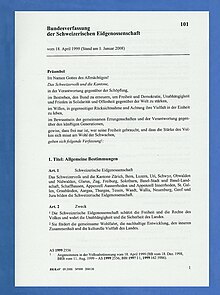Swiss Federal Constitution
This article has multiple issues. Please help improve it or discuss these issues on the talk page. (Learn how and when to remove these messages)
|
| Federal Constitution of the Swiss Confederation of 18 April 1999 | |
|---|---|
 First page of the German version of the constitution of 1999. | |
| Original title | [[[German language|German]]: Bundesverfassung der Schweizerischen Eidgenossenschaft (BV) French: Constitution fédérale de la Confédération suisse (Cst.) Italian: Costituzione federale della Confederazione Svizzera (Cost.) Romansh: Constituziun federala da la Confederaziun svizra] Error: {{Lang}}: unrecognized language tag: de, fr, it (help) |
| Created | 18 December 1998 |
| Presented | 18 December 1998 |
| Ratified | 18 April 1999 |
| Date effective | 1 January 2000 |
| Location | SR 101 |
| Media type | webpage, PDF |
| Subject | Swiss Constitution |
| This article is part of a series on the |
 |
|---|
|
|

The Federal Constitution of the Swiss Confederation (SR 10, German: Bundesverfassung der Schweizerischen Eidgenossenschaft (BV), French: Constitution fédérale de la Confédération suisse (Cst.), Italian: Costituzione federale della Confederazione Svizzera (Cost.), Romansh: )[1] of 18 April 1999 (SR 101)[2] is the third and current federal constitution of Switzerland. It establishes the Swiss Confederation as a federal republic of 26 cantons (states). The document contains a catalogue of individual and popular rights (including the right to call for popular referenda on federal laws and constitutional amendments), delineates the responsibilities of the cantons and the Confederation and establishes the federal authorities of government.
The Constitution was adopted by popular vote on 18 April 1999. It replaced the prior federal constitution of 1874, which it was intended to bring up to date without changing it in substance.
History
The groundwork for today's Swiss Constitution was laid with the promulgation of the Constitution of 12 September 1848, which was influenced by the ideas of the United States Constitution and the French Revolution. This constitution provided for the cantons' sovereignty, as long as this did not impinge on the Federal Constitution. This constitution was created in response to a 27-day civil war in Switzerland, the Sonderbundskrieg.
The Constitution of 1848 was partly revised in 1866, and wholly revised in 1874. This latter constitutional change introduced the referendum at the federal level. Beginning in 1891, the constitution contained the "right of initiative", under which a certain number of voters could make a request to amend a constitutional article, or even to introduce a new article into the constitution. This mechanism is called federal popular initiative. Thus, partial revisions of the constitution could be made any time.
The Federal Constitution was wholly revised for the second time in the 1990s, and the new version was approved by popular and cantonal vote on 18 April 1999. It replaces the constitution of 29 May 1874, and it contains nine fundamental rights which up until then had only been discussed and debated in the Federal Court. It came into force on 1 January 2000.
Owing to constitutional initiatives and counterproposals, the Swiss Constitution is subject to continual changes.
Constitutional provisions
| This article is part of the series: |
| Swiss Federal Constitution |
|---|
 |
| Text of the Constitution |
Preamble and Title 1
The preamble and the first title of the Constitution determine the general outlines of Switzerland as a democratic federal republic of 26 cantons governed by the rule of law.
The preamble opens with a solemn invocation of God in continuance of Swiss constitutional tradition. It is a mandate to the State authorities by the Swiss people and cantons, as the Confederation's constituent powers, to adhere to the values listed in the preamble, which include "liberty and democracy, independence and peace in solidarity and openness towards the world".
The general provisions contained in Title 1 (articles 1–6) define the characteristic traits of the Swiss state on all of its three levels of authority: federal, cantonal and municipal. They contain an enumeration of the constituent Cantons, affirm Cantonal sovereignty within the bounds of the Constitution and list the national languages – German, French, Italian and Romansh. They also commit the State to the principles of obedience to law, proportionality, good faith and respect for international law, before closing with a reference to individual responsibility.
Title 2: Fundamental Rights, Civil Rights and Social Goals
Title 2 contains the Constitution's bill of rights. The 1874 constitution contained only a limited number of fundamental rights, and some of them grew less significant as the 20th century wore on, such as the right to a decent burial guaranteed in article 53 of the old constitution. In consequence, the Swiss Federal Supreme Court's extensive case law developed an array of implicit or "unwritten" fundamental rights, drawing upon the case law of the European Court of Human Rights and applying the fundamental rights guaranteed in the European Convention on Human Rights (ECHR), which Switzerland ratified in 1974.
In the course of the 1999 constitutional revision, the Federal Assembly decided to codify that case law in the form of a comprehensive bill of rights, which is substantially congruent with the rights guaranteed in the ECHR, the Universal Declaration of Human Rights and the International Covenant on Civil and Political Rights.
Title 2 also covers the essential rules on the acquisition of Swiss citizenship and of the exercise of political rights. Furthermore, it contains a number of not directly enforceable "social goals" which the state shall strive to ensure, including the availability of social security, health care and housing.
See also
Bibliography
- Bernhard Ehrenzeller, Philipp Mastronardi, Rainer J. Schweizer, Klaus A. Vallender (eds.) (2002). Die schweizerische Bundesverfassung, Kommentar (in German). ISBN 3-905455-70-6.
{{cite book}}:|last=has generic name (help); Cite has empty unknown parameters:|month=,|chapterurl=, and|coauthors=(help)CS1 maint: multiple names: authors list (link). Cited as Ehrenzeller. - Andreas Kley: Federal Constitution in German, French and Italian in the online Historical Dictionary of Switzerland, 2006-12-01.
References
- ^ "SR 10 Bundesverfassung" (official website) (in German, French, and Italian). Berne, Switzerland. 10 September 2016. Retrieved 14 September 2016.
- ^ "SR 101 Bundesverfassung der Schweizerischen Eidgenossenschaft" (official website) (in German, French, and Italian). Berne, Switzerland. 1 January 2016. Retrieved 14 September 2016.
English is not an official language of the Swiss Confederation. This translation is provided for information purposes only and has no legal force.

